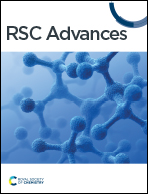Improved catalytic activity and bactericidal behavior of novel chitosan/V2O5 co-doped in tin-oxide quantum dots
Abstract
The novel V2O5/chitosan (CS) co-doped tin oxide (SnO2) quantum dots (QDs) were synthesized via co-precipitation technique. The optical, structural, morphological, and catalytic properties of the concerned specimens were examined by UV-Vis, PL, FTIR, X-ray diffraction, HR-TEM, and EDS. Structural analysis through XRD confirmed the tetragonal structure of SnO2; meanwhile, HR-TEM measurements unveiled quantum dot morphology. Rotational and vibrational modes related to functional groups of (O–H, C–H, Sn–O, and Sn–O–Sn) have been assessed with FTIR spectra. Through UV-Vis spectroscopy, a reduction in band-gap (4.39 eV to 3.98 eV) and redshift in co-doped spectra of SnO2 were identified. Both CS/SnO2 and V2O5-doped CS@SnO2 showed promising catalytic activity in all media. Meanwhile, CS/SnO2 showed higher activity for use in hospital and industrial dye degradation in comparison to dopant-free Ch/SnO2. For V2O5/CS@ SnO2 QDs, inhibition domains of G –ve were significantly confirmed as 1.40–4.15 mm and 1.85–5.45 mm; meanwhile, for G +ve were noticed as 2.05–4.15 mm and 2.40–5.35 mm at least and maximum concentrations, correspondingly. These findings demonstrate the efficient role of V2O5/CS@SnO2 QDs towards industrial dye degradation and antimicrobial activity.



 Please wait while we load your content...
Please wait while we load your content...